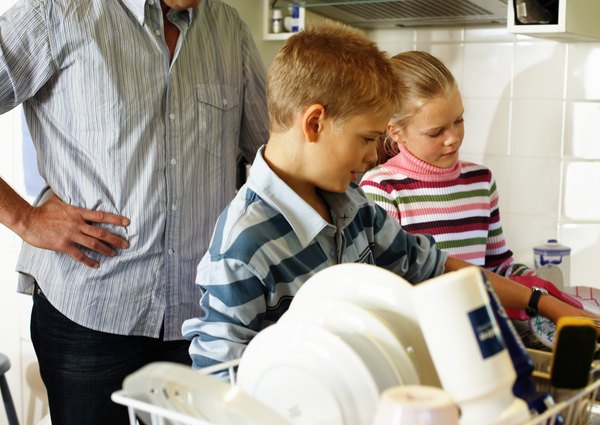
Chemical reactions happen when two substances are combined and a change occurs in the resulting mixture. Many reactions can be created using common household items such as vinegar, food coloring, dish soap and salt. Some reactions are very messy and should be done outside if possible.
Indoor Activities

Create hydrogen bubbles by putting an iron nail into vinegar. Dissolve the calcium out of an eggshell by soaking it in vinegar. Put chalk into vinegar to make carbon dioxide bubbles. Pour some whole milk into a bowl and allow it to warm to room temperature. Add a few drops of food coloring, then a few drops of liquid dish soap. The liquid soap will break down the fat in the milk and cause the colors to swirl. Some chemical experiments require more time. Soak a paper towel with vinegar and place a copper penny on top. Leave the penny for a day and observe the changes to the surface. Copper in the penny will react with oxygen in the air to change the color of the penny.
Outdoor Activities

Some experiments are very messy and should be performed outside. Add a package of Mentos to a 2-liter bottle of Diet Coke. The resulting fountain of soda can be very large. The gum arabic and gelatin in the Mentos combine with the caffeine, artificial sweetner (aspartme) and preservative (potassium benoate) to release all of the carbon dioxide at once. If performing this experiment inside, place the Coke bottle in a large pan. Place a spoonful of washing powder in a bowl and add several drops of vinegar. When the bubbling stops there will be a layer of salt at the bottom of the bowl that is not edible.
Tips

Read the instructions for an experiment completely before starting. Food coloring stains, so prepare the area and wear protective clothing such as a paint shirt. Clean all bowls and containers thoroughly after completing an experiment. Never taste any remaining residue unless the instructions state it is safe.
References
About the Author
Based in Minneapolis, Dawn Marcotte has been writing for more than 10 years. Her recent writing has turned to nonfiction and includes articles on home and garden, education, crafts and automotive subjects. She currently has several eBooks published and available online. Marcotte has a Bachelor of Science in elementary education from the University of Iowa.
Photo Credits
Hemera Technologies/Photos.com/Getty Images
